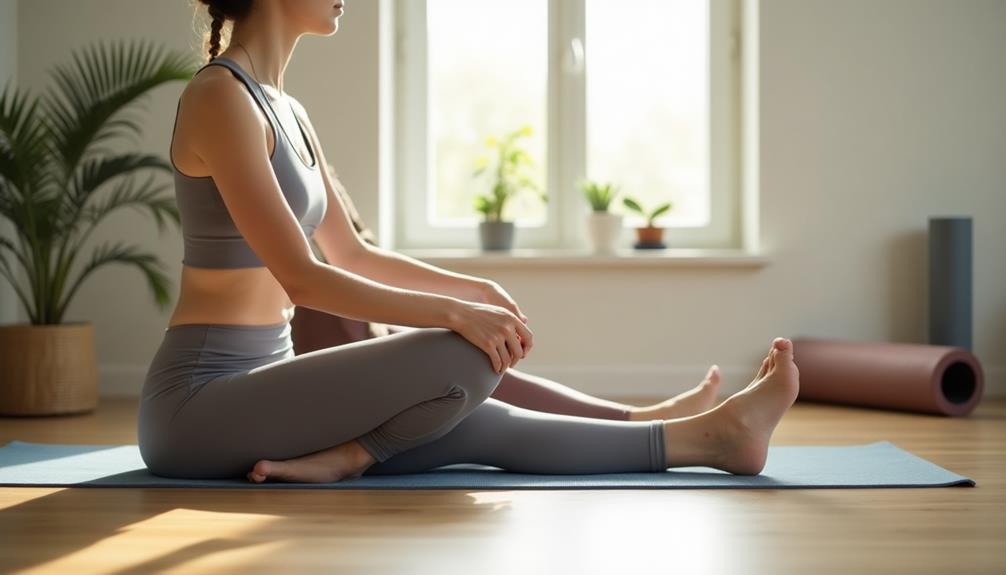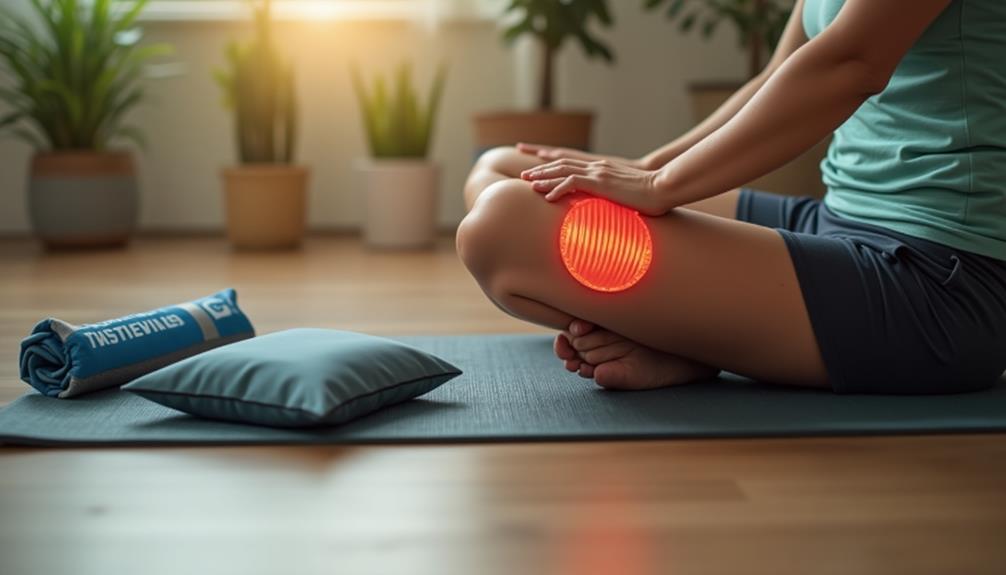To recover effectively from leg day, consider these essential tips. First, stay hydrated; drink plenty of water and include electrolytes. Next, engage in light cardio like walking or swimming to boost blood flow. Incorporate stretching routines with dynamic and static stretches. Foam rolling can also help release tight muscles. Additionally, try yoga or Pilates for flexibility and core strength. Don't forget to consume protein-rich foods within two hours after working out. Take active breaks throughout the day to stay loose, and use heat and cold therapy for muscle relief. Finally, always listen to your body for peak recovery. For more details, you'll find additional insights ahead.
Core Insights
- Stay hydrated by drinking water or electrolyte-rich beverages before, during, and after your leg day session to support recovery.
- Engage in light cardio activities like brisk walking or cycling to increase blood flow and enhance muscle recovery.
- Incorporate dynamic and static stretching routines to improve flexibility and reduce muscle tightness after workouts.
- Use foam rollers on major muscle groups to relieve tension and promote blood circulation for faster recovery.
- Prioritize sleep by establishing a consistent schedule and creating a relaxing bedtime routine to boost recovery efficiency.
Stay Hydrated

Aim to drink water before, during, and after your session. Consider keeping a water bottle close by, making it easier to sip throughout your workout. If you're sweating heavily, you might want to incorporate electrolyte-rich coconut water or sports drinks to replenish lost minerals and support best hydration. These beverages can provide essential nutrients like potassium, which is vital for muscle function and recovery. Remember, staying hydrated isn't just about quenching your thirst; it's about supporting your body's recovery process and ensuring you're prepared for your next workout.
Engage in Light Cardio

Engaging in light cardio after leg day can greatly enhance your recovery process. This low-intensity activity helps increase blood flow to your muscles, delivering essential nutrients and oxygen. You don't need to go all out; a brisk walk, easy cycling, or gentle swimming for 20 to 30 minutes works wonders. To further support your recovery, consider incorporating electrolyte gummies into your post-workout routine, as they can help replenish essential minerals lost through sweat and support optimal hydration.
Light cardio also helps flush out lactic acid, reducing soreness and stiffness. Aim to keep your heart rate at a comfortable level, around 50-60% of your maximum. This keeps the workout enjoyable and sustainable.
Incorporating light cardio into your recovery routine promotes overall mobility and flexibility, setting you up for success in your next workout. Remember, the goal is to keep moving without overexerting yourself.
Incorporate Stretching Routines

Incorporating stretching exercises into your post-leg day recovery is crucial for maintaining flexibility and preventing stiffness. Focus on both dynamic and static stretches to target your legs effectively. Start with gentle dynamic stretches, like leg swings and walking lunges, to warm up your muscles. After your workout, shift to static stretches, holding each pose for 20 to 30 seconds. Key stretches include hamstring stretches, quadriceps stretches, and calf stretches. For improved recovery and muscle pain reduction, consider using mobility tools like foam rollers or massage sticks alongside your stretching routine. These tools can help target specific muscle groups and promote better blood flow. Remember to breathe deeply during each stretch, allowing your muscles to relax. Aim to stretch at least three times a week, especially after leg workouts. This practice not only aids recovery but also enhances your overall performance in future workouts. Prioritizing stretching can greatly enhance your mobility and reduce soreness.
Use Foam Rollers

Using foam rollers is an effective way to enhance your post-leg day recovery and alleviate muscle soreness. These handy tools help release tight muscles and improve blood flow. When using a foam roller, focus on your quads, hamstrings, calves, and glutes.
Here's a quick guide on how long to spend on each area:
| Muscle Group | Time (Minutes) |
|---|---|
| Quads | 1-2 |
| Hamstrings | 1-2 |
| Calves | 1-2 |
| Glutes | 1-2 |
Roll slowly over each area, pausing on tender spots for extra relief. Foam rolling not only helps with soreness but also promotes flexibility, setting you up for a smoother workout next time.
Try Yoga or Pilates

When you engage in yoga, you stretch tight muscles and improve your range of motion. Gentle poses like downward dog or pigeon can release tension in your legs.
Pilates, on the other hand, emphasizes controlled movements that strengthen your core while stretching your limbs.
Incorporating these practices into your routine just a couple of times a week can notably enhance your recovery. You'll likely notice improved muscle elasticity and reduced discomfort. Plus, they offer a calming mental break, helping you recharge for your next workout.
Prioritize Sleep

To improve your sleep quality, establish a consistent sleep schedule. Go to bed and wake up at the same time every day, even on weekends. Create a relaxing bedtime routine, which might include activities like reading or meditating. Guarantee your sleep environment is dark, quiet, and cool to promote restful sleep.
Avoid caffeine and heavy meals close to bedtime, as they can disrupt your sleep patterns. Prioritizing sleep will help you recover faster and feel ready for your next workout.
Consume Protein-Rich Foods

How can you speed up your recovery and muscle growth after leg day? One effective way is to consume protein-rich foods. Protein plays an essential role in repairing muscle fibers that undergo stress during workouts. Aim for a post-workout meal or snack that includes quality protein sources like chicken, fish, eggs, or plant-based options such as lentils and quinoa.
Incorporating protein within 30 minutes to two hours after your workout can maximize muscle recovery. A good rule of thumb is to consume about 20-30 grams of protein, depending on your body weight and activity level. Don't forget to pair your protein with carbohydrates to replenish glycogen stores. This combination helps you get back on track and ready for your next leg day.
Take Active Breaks

Aim for short, 5 to 10-minute sessions every hour. These breaks help reduce soreness and stiffness, making it easier to return to your next workout.
Listen to your body; if you feel fatigued, adjust the intensity of your activities. Incorporating these active breaks into your routine will keep your legs feeling fresh and ready to tackle your next leg day with confidence. Your body will thank you in the long run!
Utilize Heat and Cold Therapy

After taking those active breaks, incorporating heat and cold therapy can further enhance your recovery process. Heat therapy helps increase blood flow, which can soothe tight muscles and promote healing. You can use a heating pad or warm towels for about 15-20 minutes to relax your legs.
On the other hand, cold therapy reduces inflammation and numbs sharp pain. Apply ice packs wrapped in a cloth for 15-20 minutes after your workout. Alternating between heat and cold can also be beneficial. This method not only alleviates soreness but also helps improve mobility.
Always remember to listen to your body's response to these therapies. Finding the right balance between heat and cold can optimize your recovery and keep you feeling great after leg day.
Listen to Your Body

Listening to your body is vital for effective recovery after leg day. Pay attention to how you feel throughout the day and the following days. If you're experiencing excessive soreness or fatigue, it might be a sign to slow down. Allow yourself time to rest and avoid pushing through pain. Gentle movements like walking or stretching can help promote blood flow without overexerting yourself.
Stay mindful of your hydration and nutrition, as these play an important role in recovery. If something feels off, don't hesitate to adjust your routine. Trusting your instincts can prevent injury and enhance your overall performance. Remember, effective recovery isn't just about the exercises; it's about tuning into your body's signals for a pain-free experience.
Frequently Asked Questions
How Long Should I Wait Before Exercising My Legs Again?
After leg day, your legs might feel like jelly, but don't rush back. Wait at least 48 hours before exercising them again. This gives your muscles time to recover, helping you avoid injury and improve performance.
What Are Signs of Overtraining After Leg Day?
After leg day, you might notice persistent soreness, fatigue, decreased performance, irritability, or disrupted sleep. If these signs appear, it's time to reassess your training intensity and give your body the recovery it needs.
Can I Combine Recovery Techniques for Better Results?
Think of recovery techniques as puzzle pieces; when combined, they create a complete picture. You can absolutely mix methods like stretching, foam rolling, and hydration for enhanced results, so don't hesitate to experiment and find what works.
Are There Specific Foods to Avoid Post-Workout?
Yes, you should avoid sugary snacks, processed foods, and excessive fats after a workout. These can hinder your recovery and energy levels. Focus on whole foods that support muscle repair and replenishment instead.
How Does Stress Affect Muscle Recovery?
Imagine running a marathon but getting caught in a storm; stress can feel like that. It hampers muscle recovery by elevating cortisol levels, decreasing protein synthesis, and leaving you feeling fatigued and sore longer than necessary.

